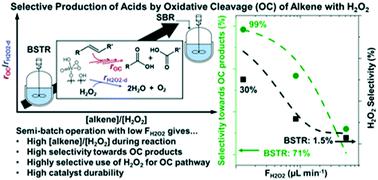当前位置:
X-MOL 学术
›
React. Chem. Eng.
›
论文详情
Our official English website, www.x-mol.net, welcomes your feedback! (Note: you will need to create a separate account there.)
Catalyst and reactor design considerations for selective production of acids by oxidative cleavage of alkenes and unsaturated fatty acids with H2O2
Reaction Chemistry & Engineering ( IF 3.9 ) Pub Date : 2022-06-10 , DOI: 10.1039/d2re00160h Danim Yun 1 , Zhongyao Zhang 1 , David W. Flaherty 1
Reaction Chemistry & Engineering ( IF 3.9 ) Pub Date : 2022-06-10 , DOI: 10.1039/d2re00160h Danim Yun 1 , Zhongyao Zhang 1 , David W. Flaherty 1
Affiliation

|
Oxidative cleavage of alkenes and unsaturated fatty acids with hydrogen peroxide gives an efficient and sustainable process to obtain mono- and di-acids for polymers and lubricants with fewer safety risks and less environmental impact than processes that utilize ozone or other inorganic oxidizers (e.g., permanganate, dichromate, etc.). Guided by insight into the mechanisms for competing reaction pathways (i.e., epoxidation of alkene on W–(η2-O2) complexes vs. H2O2 decomposition) and the apparent kinetics derived from kinetic experiments, here, we postulate that W-based heterogeneous catalysts can provide high performance and stable operations at low H2O2 concentrations. Semi-batch reactors with continuous introduction of H2O2 solutions offer the means to maintain low H2O2 concentrations while providing sufficient quantities of H2O2 to satisfy the reaction stoichiometry. We derived simple kinetic model equations for the epoxidation, ring-opening, oxidative cleavage, and oxidation steps and fit theses equations to batch experimental data to obtain kinetic parameters. This kinetic model describes the concentration profiles of reactant, oxidant, and products well as shown by agreement with experimental data. Further predictions of the optimal H2O2 feed rate for semi-batch operation utilized by the proposed rate expressions and the reactor design equations suggest that low H2O2 feed rate increases selectivity towards oxidative cleavage products and selective use of H2O2 for oxidative cleavage pathway. Comparisons of oxidative cleavage of 4-octene in batch and semi-batch reactors show that semibatch reactors with optimized molar feed rates of H2O2 increased oxidative cleavage product selectivities (76% to 99%; with an increase in butyric acid selectivity from 1% to 55%) and H2O2 selectivity (3% to 30%). In addition, semibatch reaction conditions used avoid H2O2-mediated dissolution of W-atoms from the catalyst. Analysis of these findings suggest that solid oxide catalysts will be effective for continuous oxidative cleavage reactions if deployed within fixed-bed reactors that allow for distributed introduction of reactants and therefore low in situ concentrations of H2O2.
中文翻译:

用 H2O2 氧化裂解烯烃和不饱和脂肪酸选择性生产酸的催化剂和反应器设计考虑
用过氧化氢对烯烃和不饱和脂肪酸进行氧化裂解提供了一种高效且可持续的工艺,以获取用于聚合物和润滑剂的单酸和二酸,与使用臭氧或其他无机氧化剂(例如高锰酸盐)的工艺相比,安全风险和环境影响更小、重铬酸盐等)。以深入了解竞争反应途径的机制为指导(即烯烃在 W-(η 2 -O 2 ) 配合物与H 2 O 2上的环氧化分解)和来自动力学实验的表观动力学,在这里,我们假设 W 基非均相催化剂可以在低 H 2 O 2浓度下提供高性能和稳定的操作。连续引入 H 2 O 2溶液的半间歇式反应器提供了保持低 H 2 O 2浓度同时提供足量 H 2 O 2的方法以满足反应化学计量。我们推导出了环氧化、开环、氧化裂解和氧化步骤的简单动力学模型方程,并将这些方程拟合到批量实验数据以获得动力学参数。该动力学模型描述了反应物、氧化剂和产物的浓度分布,与实验数据一致。通过所提出的速率表达式和反应器设计方程对半间歇操作的最佳 H 2 O 2进料速率的进一步预测表明,低 H 2 O 2进料速率增加了对氧化裂解产物的选择性和 H 2 O 2的选择性使用用于氧化裂解途径。比较间歇式和半间歇式反应器中 4-辛烯的氧化裂解表明,具有优化 H 2 O 2摩尔进料速率的半间歇式反应器提高了氧化裂解产物的选择性(76% 至 99%;丁酸选择性从 1 % 至 55%)和 H 2 O 2选择性(3% 至 30%)。此外,使用的半间歇反应条件避免了 H 2 O 2介导的 W 原子从催化剂中溶解。对这些发现的分析表明,如果将固体氧化物催化剂部署在允许分布式引入反应物的固定床反应器中,那么固体氧化物催化剂对于连续氧化裂解反应将是有效的,因此低H 2 O 2的原位浓度。
更新日期:2022-06-10
中文翻译:

用 H2O2 氧化裂解烯烃和不饱和脂肪酸选择性生产酸的催化剂和反应器设计考虑
用过氧化氢对烯烃和不饱和脂肪酸进行氧化裂解提供了一种高效且可持续的工艺,以获取用于聚合物和润滑剂的单酸和二酸,与使用臭氧或其他无机氧化剂(例如高锰酸盐)的工艺相比,安全风险和环境影响更小、重铬酸盐等)。以深入了解竞争反应途径的机制为指导(即烯烃在 W-(η 2 -O 2 ) 配合物与H 2 O 2上的环氧化分解)和来自动力学实验的表观动力学,在这里,我们假设 W 基非均相催化剂可以在低 H 2 O 2浓度下提供高性能和稳定的操作。连续引入 H 2 O 2溶液的半间歇式反应器提供了保持低 H 2 O 2浓度同时提供足量 H 2 O 2的方法以满足反应化学计量。我们推导出了环氧化、开环、氧化裂解和氧化步骤的简单动力学模型方程,并将这些方程拟合到批量实验数据以获得动力学参数。该动力学模型描述了反应物、氧化剂和产物的浓度分布,与实验数据一致。通过所提出的速率表达式和反应器设计方程对半间歇操作的最佳 H 2 O 2进料速率的进一步预测表明,低 H 2 O 2进料速率增加了对氧化裂解产物的选择性和 H 2 O 2的选择性使用用于氧化裂解途径。比较间歇式和半间歇式反应器中 4-辛烯的氧化裂解表明,具有优化 H 2 O 2摩尔进料速率的半间歇式反应器提高了氧化裂解产物的选择性(76% 至 99%;丁酸选择性从 1 % 至 55%)和 H 2 O 2选择性(3% 至 30%)。此外,使用的半间歇反应条件避免了 H 2 O 2介导的 W 原子从催化剂中溶解。对这些发现的分析表明,如果将固体氧化物催化剂部署在允许分布式引入反应物的固定床反应器中,那么固体氧化物催化剂对于连续氧化裂解反应将是有效的,因此低H 2 O 2的原位浓度。



























 京公网安备 11010802027423号
京公网安备 11010802027423号